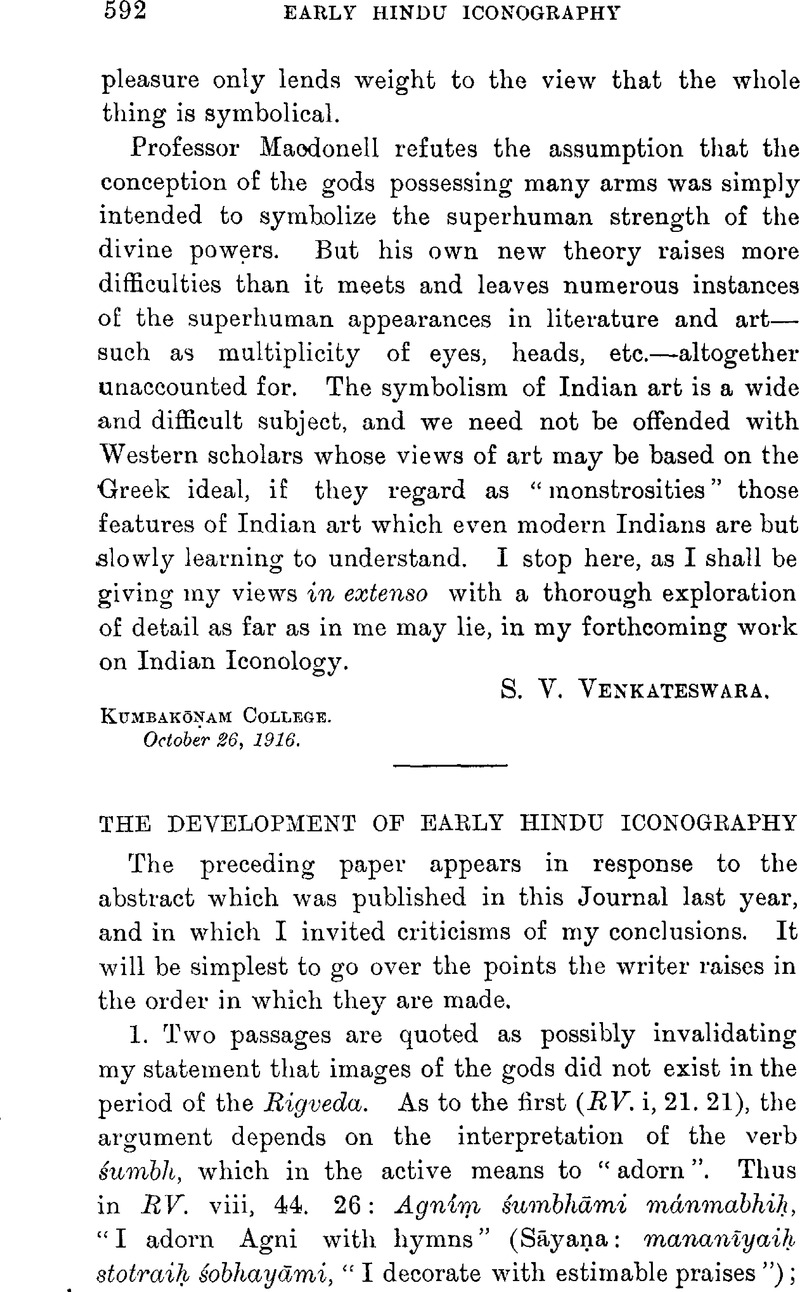No CrossRef data available.
Published online by Cambridge University Press: 15 March 2011

page 594 note 1 I have heard of, though not seen, a contrivance used in India at the present day, by which water is made to drip from a pot through a brass pipe on to the top of a liṅga (which is a symbol, not an image). Can he have meant this?
page 595 note 1 In the Festschrift, p. 164, n. 4, I point out that even Indra is in quite modern art represented with four arms on his elephant.
page 595 note 2 See my Vedic Mythology, p. 55.Google Scholar
page 595 note 3 In a ruined temple at Deogarh (Jhansi district) there is a two-armed figure of Indra (c. 700 a.c.) seated on his elephant Airāvata and holding a vajra in his right hand as well; see Gopinātha Rao's Elements of Hindu Iconography, pl. xxxii, pp. 111–12. I possess four photographs of different sculptured figures of Indra seated on his elephant.
page 596 note 1 See Smith, Vincent, A History of Fine Art in India and Ceylon, fig. li, p. 83; fig. 60, p. 109.Google Scholar
page 596 note 2 Op. cit., p. 106 f.
page 596 note 3 Op. cit., p. 187; Gopinātha Rao, 's Elements of Hindu Iconography, pls. lxxxviii, lxxxixGoogle Scholar; Archœological Survey of Mayūrabhanja, vol. i, plate facing p. xix.Google Scholar
page 596 note 4 At Ellora, Patna, and Konārak.
page 596 note 5 One of these, found at Hazaribagh, is even a seated figure, with nothing to identify the god beyond the two lotuses.
page 597 note 1 Allan, , Catalogue of the Coins of the Gupta Dynasties, London, 1914.Google Scholar
page 597 note 2 In the Festschrift, p. 162Google Scholar, n. 2, I note that Padmā-Lakṣmī appears with four arms, and p. 164, n. 7, that she is thus depicted by modern Hindu artists.
page 597 note 3 Allan, , Catalogue of the Coins of the Gupta Dynasties, p. 147 f.Google Scholar
page 597 note 4 Perhaps this assertion may require modification.
page 597 note 5 I have two others from Bodh Gayā in which a two-armed Pārvatī is seated beside a four-armed Śiva, with Śiva's foot resting on a bull and Pārvatī's on a tiger, represented below.
page 597 note 6 Thus, in a photograph I have Indrāṇī (two-armed) is seated on an elephant (Cuttack district).
page 600 note 1 Elements of Hindu Iconography, p. 90.Google Scholar
page 600 note 2 Op. cit., pl. xxxi.
page 600 note 3 Op. cit., pl. xxix.
page 600 note 4 See Allan, , Catalogue of the Coins of the Gupta Dynasties, pp. 84–6.Google Scholar
page 601 note 1 See Festschrift, p. 167Google Scholar, n. 1, where it is pointed out that in the Bhāgavata Purāṇa the epithet catur-mukha is explained with reference to the points of the compass.
page 601 note 2 Applied to Indra and Agni in the RV. and to Rudra in the VS.
page 601 note 3 Cf. his epithet (vii, 3. 1) tápur-mūrdhan, “having a burning head.”
page 601 note 4 When Agni is said in the RV. to have two births (dvijánman) and two mother-parents (dvimātṛ), the allusion is to his production from the two kindling sticks (aránīs), and his epithet “seven-rayed” (septáraśmi) refers to the conventional number of his tongues or flames; cf. Vedic Mythology, pp. 89, 93.Google Scholar
page 601 note 5 Festschrift, p. 163, n. 2.Google Scholar
page 601 note 6 In the earliest inscribed statue (a.d. 458) of Śiva, found at Kosam, Allahabad, that god (as well as Pārvatī who stands beside him) has one head and two arms.
page 602 note 1 In a letter dated April 17, 1916, Professor Vogel wrote to me that he agreed with my mam conclusions as stated in my article on “The Development of Early Hindu Iconography” in the Festschrift Ernst Windisch.